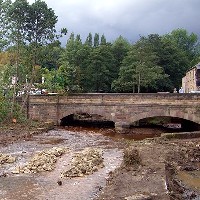Floods have caused more than 60 percent of all bridge failures in the U.S. in the past 30 years, more than all other causes combined. Yet up to now, there have been no systematic ways of measuring the damage caused by floods on the bridge supports at the river bottom.
Xiong “Bill” Yu, assistant professor of civil engineering at Case Western Reserve University in Cleveland, Ohio has developed a set of tools to fill this data gap: underwater sensors to report on the turbulence of the flood water, as well as amount of the river bottom stripped away during floods and resulting stability of the bridge supports.
Flooding, says Yu, causes vortices — spinning, turbulent water flows that erode the sand, clay, or rock where the bridge support meets the river bottom. Yu’s lab developed sensors that measure the direction and speed of the turbulence, based on similar hair-like sensors found on salmon that tell the fish the direction and speed of the surrounding water.
Yu’s lab also built sensors that measure the topography where the water meets the river bottom around the bridge supports, to provide data on the amount of sediment stripped away. This technology uses radar fired along waveguides at various locations that reflect and return at different speeds, depending on the type of material encountered and the distance traveled. A mathematical formula developed in Yu’s lab then computes the depth and density of the materials based on these reflections.
Yu’s work is funded by a National Science Foundation Faculty Early Career Development (CAREER) grant.


 RSS - Posts
RSS - Posts
[…] Related: Sensors Developed to Measure Flood Damage to Bridges […]